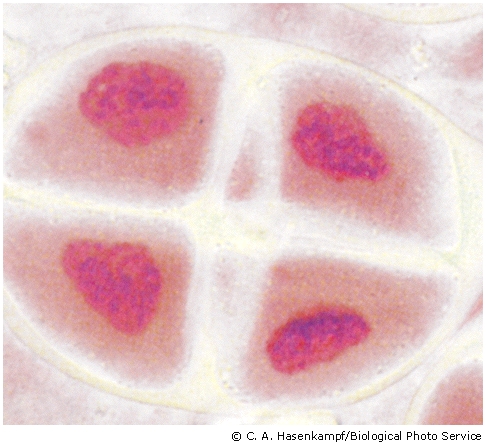

We have covered mitosis which is asexual reproduction. In asexual reproduction, one parent passes a duplicate of its genes (DNA molecules) to its offspring, which can only be genetically identical clones of the parent.
Meiosis is sexual reproduction in either animals or plants. It only occurs in germ (reproductive) cells and each parent contributes one gene for each trait. Genes for each trait come in slightly different forms called alleles. Different alleles were originally produced by mutations. We'll discuss this in more detail in the next lecture. Sexual reproduction results in new combinations of genetic traits.
Meiosis shuffles the alleles during gamete formation. Gametes of opposite sexes meet and fertilization produces offspring with unique combinations of alleles. The variation generated by sexual reproduction is the testing ground for natural selection and is the basis for evolutionary change.
At the end of meiosis, each cell has half the chromosomes it originally had. Meiosis begins with diploid (2n = 46 in humans) germ cells and produces haploid gametes (n = 23). In 2n cells there are two chromosomes of each type, called homologous chromosomes. Homologous chromosomes line up during meiosis.
Meiosis produces gametes that have one of each pair of homologous chromosomes, i.e., they are haploid.
Mitosis has one division, Meiosis has two
In some ways meiosis resembles mitosis:
REVIEW: The essence of meiosis is that each gamete receives one member of each pair of homologous chromosomes and ��
REVIEW: Through meiosis
a. alternate forms of genes are shuffled.
b. parental DNA is divided and distributed to forming gametes.
c. the diploid chromosome number is reduced to haploid.
d. offspring are provided with new gene combinations.
e. all of these��
REVIEW: If a parent cell has 16 chromosomes and undergoes meiosis, the resulting cells will have how many chromosomes?��
REVIEW: Copies of chromosomes linked together at their centromeres at the beginning of meiosis are appropriately called what kind of chromatids?� �
REVIEW: Meiosis typically results in the production of��
REVIEW: �Gamete formation is�
REVIEW: �Which does NOT produce variation?�
REVIEW: �Sexual reproduction requires _____ .
a. meiosis
b. gamete formation
c. fertilization
d. all of the above�
REVIEW: An animal cell having two rather than one of each type of chromosome has a _____ chromosome number.��
REVIEW: �Generally, a pair of homologous chromosomes _____ .
a. carry the same genes
b. are the same length, shape
c. interact at meiosis
d. all of the above�
REVIEW: Meiosis _____ the parental chromosome number.��
REVIEW: Meiosis is a division mechanism that produces _____ .�
REVIEW: Before the onset of meiosis, all chromosomes are _____ .��
PREVIOUS
NEXT
LECTURE 5 INDEX
MAIN INDEX